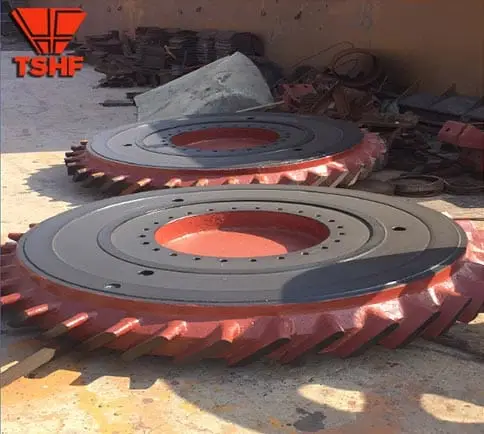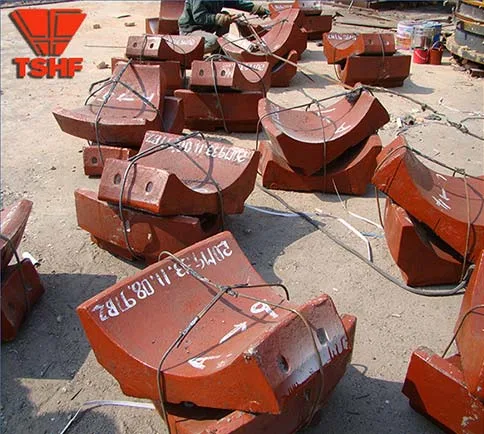Table of Contents
Introduction
Coal mill liners act as protective armor inside the mill chamber, shielding the shell from wear and impact while promoting efficient grinding. More importantly, they play a major role in the movement and mixing of the grinding media and raw materials. Without effective liners, performance drops, downtime increases, and operational costs can skyrocket.
The choice between dry and wet grinding affects the type of coal mill liner you need. In dry grinding, the environment is harsher due to higher impact forces and friction. Wet grinding, on the other hand, introduces issues like corrosion and slurry movement, requiring different liner characteristics.
Whether you operate in thermal energy, cement production, or coal-to-liquid fuel applications, selecting the right coal mill liner can dramatically improve reliability and output.

Understanding the Grinding Process: Dry vs Wet Milling
Dry grinding is commonly used in environments where moisture must be avoided—such as in cement kilns or pulverized fuel systems. It involves no water or liquid additives and usually results in a fine, powdery output that’s ideal for further processing or combustion.
The benefits of dry grinding include simpler system configurations, no need for slurry handling, and lower initial investment. However, it also comes with higher dust levels, increased liner wear due to friction, and often, higher power consumption.
Wet grinding, by contrast, mixes coal with water or other liquids, forming a slurry that facilitates particle breakage. This method is especially popular in coal slurry preparation for synthetic fuels and certain mineral processing plants.
Wet grinding lowers mill temperature, minimizes dust explosion risks, and reduces noise and liner wear—but it also requires more complex handling systems and corrosion-resistant materials.
| Grinding Method | Coal Mill Liner Wear | Dust Generation | Maintenance Frequency | Ideal For |
|---|---|---|---|---|
| Dry Grinding | High | High | Frequent | Cement Plants, Pulverized Fuel Prep |
| Wet Grinding | Medium | Low | Moderate | Coal Slurry Fuel, Mineral Processing |
Choosing the Right Coal Mill Liners for Your Application
Every grinding environment is different. That means your coal mill liners must be chosen according to several critical factors including mill speed, coal properties, load volume, and moisture content.
For dry grinding, liners need to withstand high impact and abrasive forces. This often means using high-chrome white iron or alloy steel liners with advanced surface hardening. These materials resist wear but may be brittle under shock loads if improperly supported.
For wet grinding, the environment is more forgiving in terms of mechanical impact but harsher in terms of corrosion. Composite liners (a mix of rubber and metal), rubber liners, or polymer-based solutions tend to work best here, offering both shock absorption and chemical resistance.
| Liner Material | Best Suited For | Application Notes |
|---|---|---|
| High Chrome Steel | Dry Grinding | Excellent wear resistance, higher cost |
| Rubber Composite Liners | Wet Grinding | Good for reducing impact noise, lower weight |
| Manganese Steel | Both | Great shock absorption, moderate wear |
| Ceramic Liners | Dry (low impact) | High wear resistance, brittle under impact |
It’s essential to evaluate not just the hardness or chemical resistance of a liner material, but also its compatibility with your mill’s speed, diameter, and charge load. Failing to do so often results in premature wear or liner failure.
Maintenance Considerations for Coal Mill Liners
No matter how good your liners are, regular maintenance remains critical. An optimized liner strategy doesn’t just rely on good materials—it also depends on predictive wear management and proper installation.
In dry grinding setups, liners are subjected to heavy abrasion and need frequent inspection. Monthly or bi-monthly visual checks, combined with liner wear sensors, help avoid sudden failures. It’s also a best practice to rotate the liners during planned shutdowns to balance out uneven wear.
In wet grinding environments, the primary concern is corrosion. Regular checks should focus on pitting, scale buildup, and slurry pooling at the bottom of the mill. Ensuring proper drainage and drying the mill during long shutdowns can extend liner life.
A 2023 industry report published by the International Journal of Mineral Processing showed that mills using condition-based monitoring systems for liner wear experienced up to 18% cost savings in liner replacement over two years, alongside a 12% increase in plant uptime.


Real-World Application Scenarios
In one cement plant operating a dry grinding system, the replacement of cast manganese liners with high-chrome variants resulted in a 30% longer liner lifespan. The plant also recorded a 5% reduction in grinding energy consumption due to improved media motion and reduced slippage.
In a coal slurry production facility using wet grinding, the adoption of rubber-metal composite liners reduced downtime by 22% during seasonal high humidity. The facility also observed better slurry flow characteristics, leading to more consistent particle sizes in the final output.
These examples show that there’s no universal “best” liner. The right solution depends on your environment, goals, and budget.
Conclusion
Whether you operate a dry or wet coal grinding system, choosing the right coal mill liners is fundamental to plant efficiency and reliability. Each grinding environment demands specific liner materials, profiles, and maintenance strategies.
Start by understanding your coal type, moisture content, mill design, and wear history. Then work with a trusted liner supplier who can help you test and optimize performance based on real operating data.
The goal isn’t just longer liner life—it’s better mill performance, fewer shutdowns, and more consistent output. The right liner is not a cost. It’s an investment.
FAQ
Can I use the same coal mill liner for both dry and wet grinding?
Technically, some materials like manganese steel can serve in both environments, but performance will always be better when the liner is matched to the specific application conditions.
How long do coal mill liners typically last?
This depends heavily on the grinding conditions, but most high-performance liners can last between 6 months and 2 years with proper maintenance.
What signs should I watch for that indicate a liner needs replacement?
Unusual noise, reduced grinding efficiency, high power draw, or uneven product sizing are all signs that liners may be failing or improperly aligned.
Are composite liners worth the cost?
Yes, especially in wet or high-impact environments. They provide good shock absorption, reduce noise, and can be easier and faster to install compared to all-metal options.
What’s the biggest mistake companies make with mill liners?
Not tailoring liners to their specific mill environment. Relying on generic solutions often leads to higher maintenance and reduced output.

